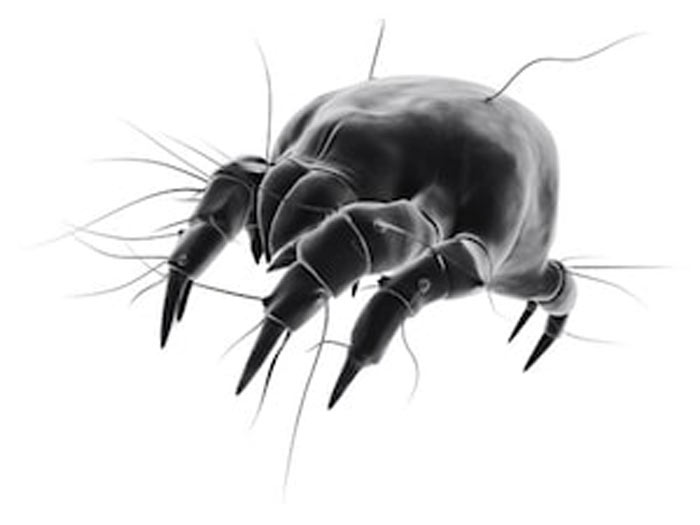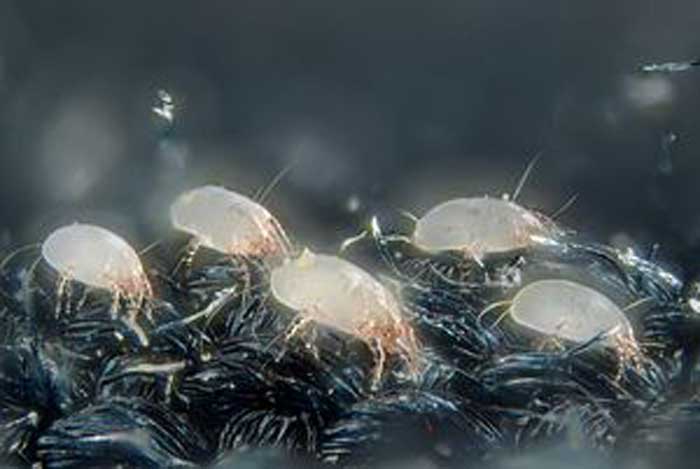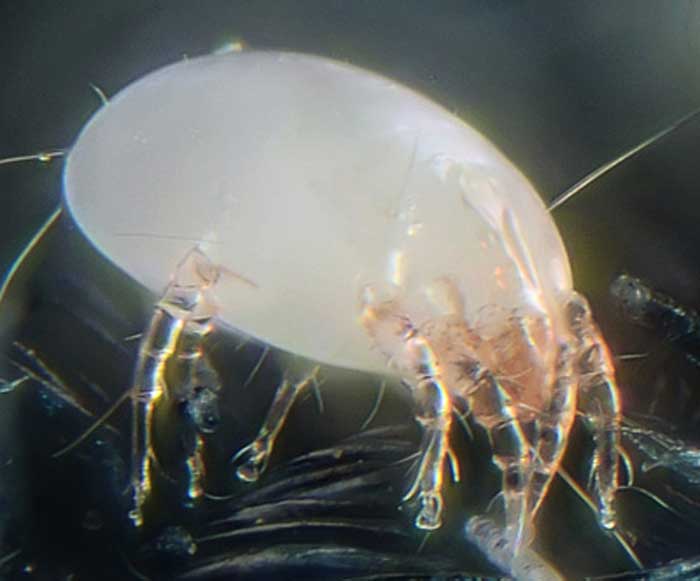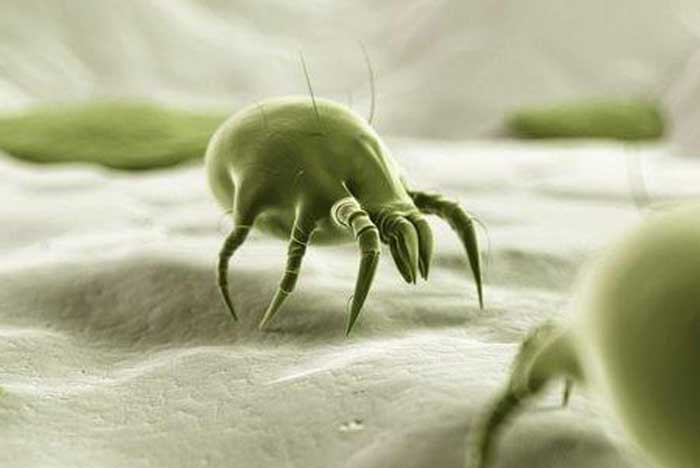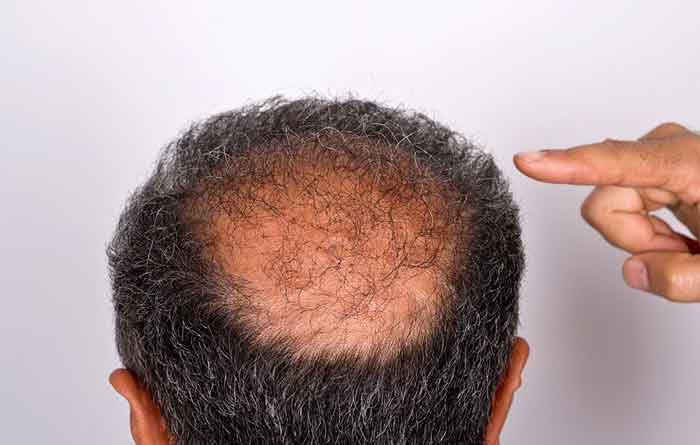Dust mites are microscopic and that means you cannot see them with your naked eye. The only way to see them is by using a magnifying glass. Sometimes, you may not see the dust mites since they hide in places that are hard to find such as in deep layers of your mattress.
Among the most common indoor allergens are the dust mites. Find out facts about what these microscopic organisms look like in pictures, where they come from and where they live, what they feed on and their general effects on humans and pets.
Table of Contents
What do Dust Mites look like?
Dust mites are very small in size. They are less than 0.5mm in length; explaining why they are not visible to the naked eye. Their body is oval shaped, they are wingless, and their body is white colored with some fine stripes.
There is no much difference on the appearance of the male from that of female dust mite. They both have a globular shape, striated cuticle, and they are creamy white.
Nevertheless, there are some few differences that can be pointed out. While the female measure about 420 microns in length, the male dust mite has an approximate length of 320microns.
The male dust mite has a pair of suckers which it uses to grasp the female dust mite during copulation. The males are seen to be more sclerotized and their legs are more enlarged. The genital opening of the female mite is well defined and it’s found near its anus.
Depending on the humidity and temperatures, the life cycle of the dust mites takes between 19 to 30 days. Females that have mated live for approximately two months.[3]
Dust mites pictures/images
What are dust Mites? Are they Insects
Dust mites are insect-like pests which are microscopic. They are known to generate most of the allergens that trigger allergic reactions in people.
Dust mites are relatives to spiders and they cannot therefore be classified as insects. They are classified as arthropods.[1] They have 8 legs as opposed to a normal insect which has six legs.
Dust mites cannot fly but they easily float on air. These mites belong to the same family as the spiders; the arachnid family. They therefore have no wings to help them fly.
Where do dust mites come from?
Dust mites are naturally occurring. They are mostly found in areas of high humidity.
Unlike human beings, dust mites do not drink water but rather, they absorb moisture from the air for their hydration.
Areas like deserts where the humidity levels are extremely low, you can hardly find dust mites since they cannot survive in such an environment.
Signs-How to know you have Dust Mites
You may want to know how to determine whether or not you have dust mites. In most cases, you will know you have dust mites if you experience the allergic reactions that are associated with presence of dust mites.
The allergic reactions include; sneezing, Itchy eyes, cough, Runny nose, and general nasal congestion.
However, using these symptoms may be inaccurate since there are other causes of such allergic reactions which may not be dust mites.
Several steps have therefore been established to help you confirm if you really have dust mites and they are as follows;
Step 1; purchase a microscope
You can use a microscope to see dust mites. Environment Safety and Health online advices that the microscope used to study dust mites needs to have the power to magnify the dust mites ten times.
This is required due to their extremely small size as already discussed above. If you use a microscope with less than the required magnification power, you are likely to conclude absence of dust mites.
Step 2; collect a dust sample
You will need to study a dust sample to determine whether or not there are dust mites in your house.
You will find dust mites mostly in the humid and warm places that also have high volumes of dust.
Dust obtained from pillows, old mattresses, blankets, or pet hair is provides the best sample for inspecting dust mites.
Step3; Collect another sample using a tape
This is applicable where you feel some crawling on your skin which comes with itching. You are required to place the tape on the part of your skin where dust mites are suspected to be crawling.
If they are present, they will attach themselves on the tape. Alabama Cooperative Extension System explains that; this method will work if and only if the dust mites are crawling.[4]
Step 5; Carry out a dust mite allergy test
This is necessary where you have carried out the tests above and none of them confirms presence of dust mites but you still suspect they are present.
If you continue to experience symptoms of dust mites’ allergy, it will be prudent to carry out an allergy test so that you do not confuse dust mites for another allergy trigger.
Where do dust mites live?
Dust mites live anywhere they find ideal conditions for their survival. In most cases, dust mites are found in bedding, mattress and pillows. The reason dust mites are found mostly in human habitats is that they find the warm temperature and reasonable humidity in which humans live to be ideal for them.
Dust mites prefer living on surfaces that are covered with fabric as it gives them the best place to burrow and make a home. Of all places where dust mites are said to live, the mattress is their favorite. This is because, it is not only warm but it is also damper compared to the other areas.
Human beings are not the only target for dust mites. These mites target other creatures as well such as your pets. When you go to the pet’s bed, you are likely to find as many dust mites as those found in your bed. Dust mites feed on the dead cells that these pets shed.
Dust mites are also found in the nests of birds and the habitats of wild animals. In conclusion on what dust mites feed on, you can state that they feed on any type of skin cell. If the survival of dust mites depended on food sources, they would live forever since dead skin is shed all the time; that means, the food supply for dust mites cannot be brought to an end.
What Do Dust Mites Eat?
The mattress has most of the food that dust mites feed on. You spend a lot of time in bed at night. You therefore shed off a lot of dead skin unknowingly and it is the main source of food for dust mites. This explains why your bed is identified as the primary home for dust mites.
Are dust mites harmful-Side Effects on Humans
Dust mites and itchiness
Most people never even realize the presence of dust mites as their skin does not react to them. However, if you are among the unfortunate minority whose skin is extremely sensitive to allergens, you will definitely know when dust mites are crawling on your skin.
Further reading: Dust mite bites
Apart from that, if you have dermatitis, you will react very badly when your skin comes into contact with dust mites and the itchiness is likely to be uncontrollable. The itchiness leaves your skin very red.[6]
The Journal of Investigative Dermatology states that, the excrement and body of the dust mites have allergens embedded on them and it is these allergens that worsen the itchiness which comes with skin conditions such as psoriasis, eczema and dermatitis.[7]
House dust mite asthma/Coughing
Approximately 90% of asthmatic people are very sensitive to dust mites. If you have asthma, you may have found yourself saying that dust triggers your asthma.
However, it is the dust termites responsible and not the dust itself. More precisely, it is the droppings of the dust mites which trigger the asthmatic problem.
The dust mites live in dust and when you are asthmatic and you are exposed to dust, the microscopic creatures make their way into your system.
What dust allergy does is to trigger asthmatic symptoms. You are always advised to keep your bed clean and sheets changed frequently if you are asthmatic; so that your environment is dust free.[8]
Dust mites and hair loss
There are many reasons that explain hair loss. Although on rare occasions, dust mites may cause allergic reactions on the scalp.
The result is severe itchiness. When you scratch your scalp so much, it begins to flake and the hair on the affected area begins to fall off.
However, hair that falls due to an allergic reaction caused by dust mites will grow back in no time.
Other effects of dust mites on humans
Most of the effects of dust mites have been discussed above and details on dust mite allergies will be discussed in a separate article.
Generally, dust mites cause discomfort in human beings. Even if you are among the lucky ones who do not experience an allergic reaction, when dust mites crawl on your skin, they cause a lot of discomfort.
As already mentioned, dust mites love your bed and that is where they spend most of their time. Thousands of dust mites are reported to be hiding in your mattress and bedding. This explains why you may end up with sleepless nights as you experience the symptoms of dust mites’ allergies.
Pets and dust mites
The article also highlights above that dust mites are not only interested on people but other creatures that shed their skin as well.
In this case, we will focus on the pets, more specifically, dogs and cats.
Unlike you who may speak up and seek assistance when you experience dust mite allergies, pets may suffer in silence.
Dogs
One out of every ten dogs is likely to suffer an allergic reaction. 30 percent of these dogs which suffer from the allergic reactions are reacting to dust mites.
As soon as a dog comes into direct contact with allergens, its immune system overreacts releasing chemicals that result into itchiness.
A dog can be exposed to dust mites in several ways; dust mite dead bodies, body parts, waste from dust mites, and live dust mites.
When your dog scratches its body when inside your house and the same does not happen when it is outside, it shows the possibility that there are dust mites in your house.
When your dog comes into contact with the allergen, you will realize that it is experiencing some discomfort since it begins to scratch its body. You will also notice that it licks all over its body and it may also chew excessively.
The most common places where the dog will show its irritation is the groin, paws, armpits, tummy, and face.
The chewing, scratching, and licking makes the skin of the dog to thicken.
The scratching makes the texture of the dog’s skin supple. The skin appears like rough lichen.
The skin may also acquire a dark pigment due to the scratching. This process is referred to as hyperpigmentation.
Sometimes, the dog may not react immediately to the allergen and it may take several instances of exposure to dust mites before any symptoms of allergies are noticed.
Nevertheless, you should not draw a conclusion that the dog has come into contact with dust mites just by observing suspected dust mite allergy symptoms. Sometimes, other substances like pollen may be causing your dog to scratch its body.
You are advised to call a veterinarian to carry out some tests on your dog so as to determine whether dust termites are causing the allergic reactions.
A physical examination is not enough and the vet may perform two main tests; serum allergy test and intradermal allergy testing.[9]
Cats
Your cat, just like the dog, suffers discomfort when it comes into contact with dust mites. You may realize that your cat keeps on scratching itself when it is on your bed. After a short while, the skin of the cat may have some red spots.
The cat will react to the allergens in the same way as dogs. The cat may start coughing, or you may realize she or he experiences difficulty in breathing.
The scratching and licking by the cats in response to the allergic reaction may result to hair loss. The skin of the cat may also develop some crusty patches and you may also notice skin damage.[10]
Further Reading
- Does Lysol Kill Dust Mites
- Dust Mite Allergy- Rash, Symptoms, Get Rid & Prevent
- Essentials Oils for Dust Mites
- Can you See Dust Mites? Pictures, They look like, Habitat, Food & more Facts
- Dust Mite Bites, Pictures, Signs + Ridding
- Dust Mite vs Bed Bug Bites
- How to get rid of Dust Mites- Natural Remedies & Chemicals
Further Reading
Sources
[1] http://housedustmite.com/house-dust-mites-formal-classification-a-quick-reference
[2] http://www.microbiologybytes.com/video/mite.html
[3] http://entnemdept.ufl.edu/creatures/urban/house_dust_mite.htm
[4] https://store.aces.edu/ItemDetail.aspx?ProductID=16507
[6] https://www.sciencenews.org/blog/scicurious/here’s-how-dust-mites-give-dermatitis-sufferers-itch
[7] http://www.vib.be/en/news/Pages/Scientists-discover-how-treating-eczema-could-also-alleviate-asthma-.aspx
[8] https://www.asthma.org.uk/advice/triggers/dust-mites/
[9] https://wagwalking.com/condition/dust-mites-allergies
[10] https://pets.thenest.com/cats-affected-dust-home-8144.html
